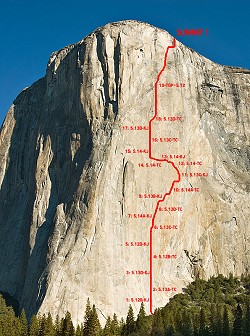
Tommy Caldwell and Kevin Jorgeson have now begun their first serious push to free their Dawn wall project on El Capitan, Yosemite.
After having worked the route for six years, all the difficult pitches had finally been climbed free in mid November. Tommy and Kevin then worked some of the pitches a bit more before taking time off the wall to prepare for the big push in December, as soon as the forecast looked promising enough.
That time is now.
They began their attempt a couple of days ago and have now finished the first 10 pitches, and although they haven't reached seriously difficult part, with three ~9a pitches back to back, yet, this "warm up" part would be a news worthy feat in itself anywhere else:
P1: 7b
P2: 7c+
P3: 8a+
P4: 7b
P5: 7c wet
P6: 8a+
P7: 8b+
P8: 8b
P9: 8a
P10: 8b+ wet
High winds are expected now and the boys are in need of a rest day anyway before they tackle the crux of the route.
After an easy ~8a+, an ~8c takes them to two traverse pitches followed by the infamous dyno pitch. Again: all of these weigh in around ~9a!
Then, the rest is "easy" as in, ~8a+, ~8b, ~8b, ~7b/c, so basically a stroll in the park...
Fingers crossed for good conditions and unsplit tips!
Tommy Caldwell is sponsored by: Black Diamond, Bluewater Ropes, Clifbar, Climb On, La Sportiva, Patagonia and REVO Sunglasses
Kevin Jorgeson is sponsored by: Black Diamond, adidas, FiveTen, Sterling Rope, Asana






Comments